

Hamilton Feature Page on Undiscovered Scotland. Hamilton lies some 11 miles south east of Glasgow close to the confluence of the Avon Water and the River Clyde and on the west side of the Clyde Valley.
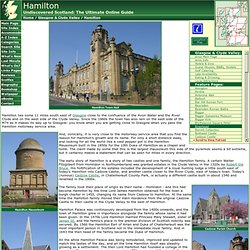
Since the 1960s the town has also lain on the east side of the M74 as it makes its way up to Glasgow: you know when you are getting close to Glasgow when you pass the Hamilton motorway service area. And, ironically, it is very close to the motorway service area that you find the reason for Hamilton's growth and its name.
For only a short distance away, and looking for all the world like a vast pepper pot is the Hamilton Mausoleum built in the 1850s for the 10th Duke of Hamilton as a chapel and tomb. The claim made by some that this is the largest mausoleum this side of the pyramids seems a bit extreme, but it certainly makes a statement that can be seen for miles in every direction. Hamilton, South Lanarkshire. Coordinates: Hamilton (Scots: Hamiltoun, Scottish Gaelic: Hamaltan)[2] is a town in South Lanarkshire, in the west-central Lowlands of Scotland.

It serves as the main administrative centre of the South Lanarkshire council area. It is the fourth-biggest town (and eighth-biggest place including cities) in Scotland. It sits 12 miles (19 km) south-east of Glasgow, 35 miles (56 km) south-west of Edinburgh and 75 miles north of Carlisle, Cumbria. Browser Population. Browser Population.
Hamilton, Scotland. Towns and Villages. Back to places Hamilton lies in the heart of Lanarkshire, where the Clyde and Avon rivers meet at the head of the Clyde Valley's rich, agricultural lands.
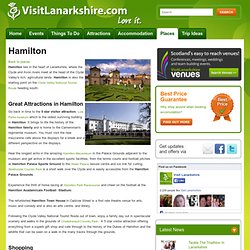
Hamilton is also the starting point on the Clyde Valley National Tourist Route heading south. Great Attractions in Hamilton Go back in time to the 5 star visitor attraction, Low Parks museum which is the oldest surviving building in Hamilton. History of Hamilton in South Lanarkshire. Low Parks Museum - South Lanarkshire Leisure and Culture. Hamilton Parish - Scottish Mining Website. Information specific to this area can be found below and on the left menu bar.

We also recommend consulting the many general pages for information of general relevance to miners' lives. Below: Cadzow St. Hamilton Mausoleum. Interior of the Mausoleum Hamilton Mausoleum is a mausoleum located in Hamilton, South Lanarkshire, Scotland.
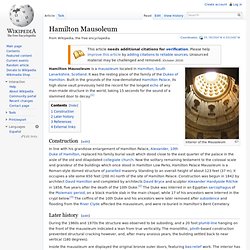
Hamilton Mausoleum. William Cullen. William Cullen FRS FRSE FRCPE FPSG (15 April 1710 – 5 February 1790) was a Scottish physician, chemist and agriculturalist, and one of the most important professors at the Edinburgh Medical School, during its heyday as the leading center of medical education in the English-speaking world.[3] He was President of the Royal College of Physicians and Surgeons of Glasgow (1746–7), President of the Royal College of Physicians of Edinburgh (1773–1775) and First Physician to the King in Scotland (1773–1790).[4] He was also, incidentally, one of the prime movers in obtaining a royal charter for the Philosophical Society of Edinburgh, resulting in the formation of the Royal Society of Edinburgh in 1783.[5] Cullen was also a successful author.
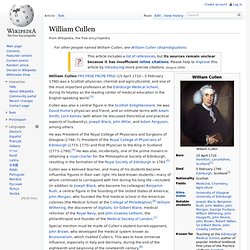
He published a number of medical textbooks, mostly for the use of his students, though they were popular throughout Europe and the American colonies as well. Early life[edit] William Cullen. Margo MacDonald. Background[edit] Margo Aitken was born in Hamilton, South Lanarkshire, and grew up in and around East Kilbride, one of three siblings.[1] Her mother, Jean, was a nurse, and her father, Robert,[2] was described as a "very cruel" man from whom her mother separated when Margo was 12 years old.[3] She was educated at Hamilton Academy, and trained as a teacher of physical education at Dunfermline College of Physical Education immediately after leaving school.[4] Family[edit] She married her first husband, Peter MacDonald, in 1965, and they ran a Blantyre pub, the Barnhill Tavern (known locally as The Hoolet's Nest), together.
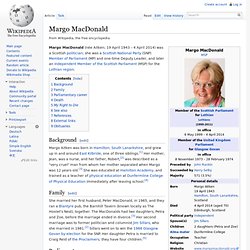
The MacDonalds had two daughters, Petra and Zoe, before the marriage ended in divorce.[3] Her second marriage was to former politician and columnist Jim Sillars, who she married in 1981.[2] Sillars went on to win the 1988 Glasgow Govan by-election for the SNP. Her daughter Petra is married to Craig Reid of the Proclaimers; they have four children.[5]
Harry Lauder. Sir Henry "Harry" Lauder (4 August 1870 – 26 February 1950) was an international Scottish entertainer, described by Sir Winston Churchill as "Scotland's greatest ever ambassador!

"[1][2][3] Early life[edit] Henry Lauder was born at Portobello, Edinburgh, where the family lived, in the home of his maternal grandfather, Henry McLennan. His father was John Currie Lauder, descended from the Lauders of the Bass,[4] and his mother was Isabella Urquhart MacLeod McLennan, born in Arbroath to a family from the Black Isle.[5] Harry's father John Lauder moved to Newbold, Derbyshire, in 1882 to take up a job designing china.
Harry Lauder. Brian Connolly. Early life[edit] Brian Connolly was born in 1945 in Govanhill, Glasgow, (some early Sweet biographies claim he was born in 1949).
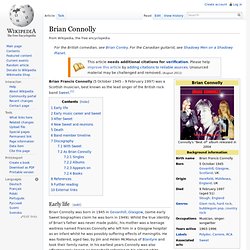
Whilst the true identity of Brian's father was never made public, his mother was a teenage waitress named Frances Connolly who left him in a Glasgow hospital as an infant whilst he was possibly suffering effects of meningitis. He was fostered, aged two, by Jim and Helen McManus of Blantyre and took their family name. In his earliest years Connolly was also affectionately known as "snowball" referring to his almost white blonde hair. In a radio interview, Connolly reported that singing was a large part of growing up since there was no television, and that he was regularly called upon to sing for family and friends.
Early music career and Sweet[edit] David Livingstone. David Livingstone (19 March 1813 – 1 May 1873) was a Scottish Congregationalist pioneer medical missionary with the London Missionary Society and an explorer in Africa.
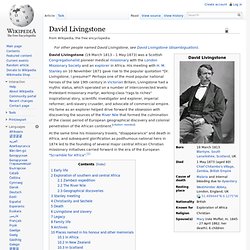
His meeting with H. M. Stanley on 10 November 1871 gave rise to the popular quotation "Dr. Livingstone, I presume? " Perhaps one of the most popular national heroes of the late 19th century in Victorian Britain, Livingstone had a mythic status, which operated on a number of interconnected levels: Protestant missionary martyr, working-class "rags to riches" inspirational story, scientific investigator and explorer, imperial reformer, anti-slavery crusader, and advocate of commercial empire.
David Livingstone & Victoria Falls. Mark McManus. Mark McManus (21 February 1935 – 6 June 1994) was a Scottish actor best known for his portrayal of Detective Chief Inspector Jim Taggart in the long-running ITV television series Taggart for eleven years until his death. Career[edit] McManus was also a boxer before acting.[2][3] He is not to be confused with the boxer of the same name (born 1974) from Basildon in England. Nicol Williamson. Nicol Williamson (14 September 1938 – 16 December 2011) was a British actor[1] once described by John Osborne as "the greatest actor since Marlon Brando".
He was also described by Samuel Beckett as "touched by genius" and viewed by many critics as "the Hamlet of his generation" during the late 1960s. Some sources incorrectly state that Williamson was born in 1936 rather than 1938.